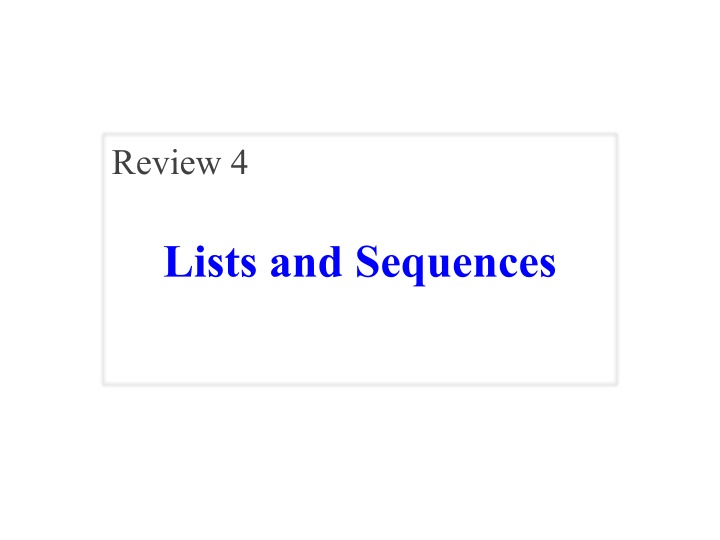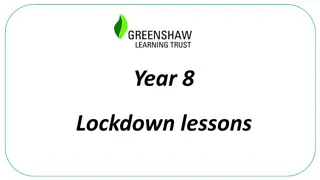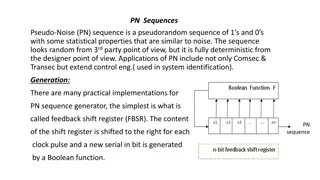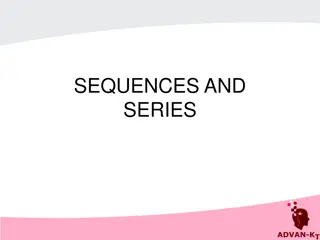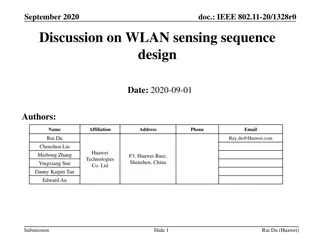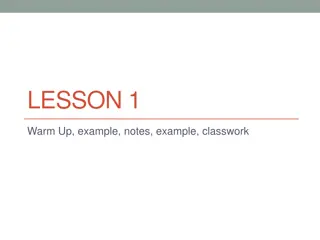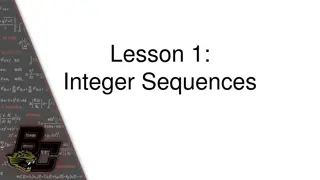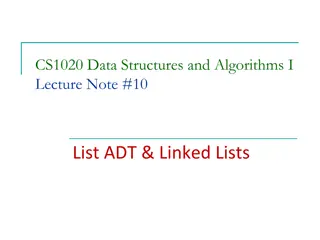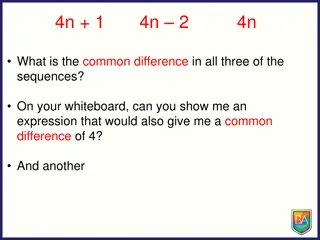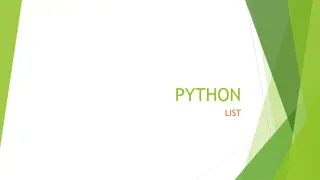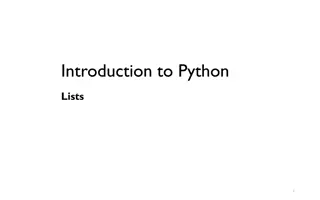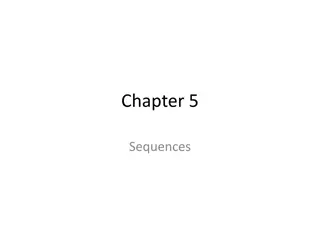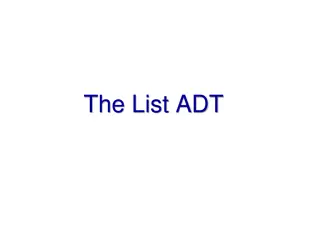Overview of Lists, Sequences, Creation, Modification
the syntax of lists, tuples, and strings in Python, understand the process of creating and modifying lists, and tackle a modified question involving histogram generation based on student scores in a test.
Download Presentation

Please find below an Image/Link to download the presentation.
The content on the website is provided AS IS for your information and personal use only. It may not be sold, licensed, or shared on other websites without obtaining consent from the author.If you encounter any issues during the download, it is possible that the publisher has removed the file from their server.
You are allowed to download the files provided on this website for personal or commercial use, subject to the condition that they are used lawfully. All files are the property of their respective owners.
The content on the website is provided AS IS for your information and personal use only. It may not be sold, licensed, or shared on other websites without obtaining consent from the author.
E N D
Presentation Transcript
Review 4 Lists and Sequences
Overview of List Syntax Create list of length 4 with all zeroes Append 2 to end of list x (now length 5) Evaluates to False (3 not in x) x = [0, 0, 0, 0] 4300112 x x.append(2 ) 4300112 -4 6 5 -8 0 1 2 3 4 0 0 0 0 2 Assign 5 to element 2 and 4 to element 0 3 in x x[2] = 5 x[0] = 4 Assign -8 to x[3] and 6 to x[1] k = 3 x[k] = 2 * x[0] 3 k
Lists vs. Tuples vs. Strings Creation x = [a1, a2, a3, ] Can contain anything len(x) is length Supports slicing Example: x[1:2] x[i] is an element Can concatenate y = x + [1, 2] Makes a new list Is mutable x.append(5) Creation x = (a1, a2, a3, ) Can contain anything len(x) is length Supports slicing Example: x[1:2] x[i] is an element Can concatenate y = x + (1, 2) Makes a new tuple Is not mutable Creation x = 'Hello' Only contains chars len(x) is length Supports slicing Example: x[1:2] x[i] is a substring Can concatenate y = x + ' World' Makes a new string Is not mutable
Modified Question 4 from Fall 2011 Each elements in the list scores contains the number of students who received score i on a test. For example, if 30 students got 85, then scores[85] is 30.Write the body of function histogram, which returns a histogram as a list of strings. (You need not write loop invariants.) For example, if scores = [7, 0, 4, 3, 2, 0, ] then the first elements of the resulting string list are: '00 *******' '01 ' '02 ****' '03 ***' '04 *' '05 '
Modified Question 4 from Fall 2011 def histogram(scores): """Return a list of Strings (call it s) in which each s[i] contains: (1) i, as a two-digit integer (with leading zeros if necessary) (2) a blank, (3) n asterisks '*', where n is scores[i]. Precondition: scores is a list of nonnegative integers, len(scores) < 100""" # IMPLEMENT ME
Modified Question 4 from Fall 2011 def histogram(scores): """Return a list of Strings (call it s) in which each s[i] contains: (1) i, as a two-digit integer (with leading zeros if necessary) (2) a blank, (3) n asterisks '*', where n is scores[i]. Precondition: scores is a list of nonnegative integers, len(scores) < 100""" s = [] # List to contain the result. for i in range(len(scores)): # Need the value i, not the elements of scores # Inv: `row` is the string for this printout line # Conditional expression version: # row = (str(i)+' ') if scores[0] > 10 else ('0'+str(i)+' ') if scores[i] > 10: row = str(i)+' ' else: row = '0'+str(i)+' ' for n in range(scores[i]): # Loop over number of elements in scores[i]
Overview of Two-Dimensional Lists Access value at row 3, col 2: 0 1 2 3 d 5 4 7 3 d[3][2] 0 1 Assign value at row 3, col 2: 2 4 8 9 7 d[3][2] = 8 3 4 An odd symmetry 5 1 2 3 Number of rows of d: len(d) Number of cols in row r of d: len(d[r]) 4 1 2 9 6 7 8
How Multidimensional Lists are Stored b = [[9, 6, 4], [5, 7, 7]] 82799054 43001122 9 6 4 5 7 7 23457811 9 6 4 5 7 7 82799054 43001122 23457811 b b holds name of a one-dimensional list Has len(b) elements Its elements are (the names of) 1D lists b[i] holds the name of a one-dimensional list (of ints) Has len(b[i]) elements
Modified Question 4 from Fall 2010 Recall drawing GRectangles in A7. Write method placeSquares, whose requirements appear below. It draws square bricks as shown to the right and returns them as a 2d list of GRectangle def placeSquares(self, m): """Create a list of m x m squares (GRectangle), as specified below, adding the squares to the GUI, and return the list.""" Method Requirements: There are m columns and rows of squares; precondition: 0 < m. Each square has side length BRICK_SIDE; there is no space between them. The bottom-left square is at the bottom-left corner (0,0) of the GUI. Squares in columns and rows 0 and m-1 have color colormodel.PINK Inner squares have checkerboard pattern of colormodel.RED and , as shown (bottom-left one is green; one next to it,
Modified Question 4 from Fall 2010 Recall drawing GRectangles in A7. Write method placeSquares, whose requirements appear below. It draws square bricks as shown to the right and returns them as a 2d list of GRectangle def placeSquares(self, m): """Create a list of m x m squares (GRectangle), as specified on last slide, adding them to the GUI, and return the list.""" API Reminders: GRectangle has attributes pos (a 2 element tuple), size (a 2 element tuple), fillcolor, and linecolor You construct a GRectangle with keyword arguments: GRectangle(pos=(0,0),size=(10,10)) You add to the GUI with self.view.add( )
def placeSquares(self, m): """Place the m x n Bricks, as requested on the exam and return the list""" bricks = []; c = 0# Make a new list to represent columns while c < m: # Place col c of bricks row = []; r = 0 # Make a new list to represent rows while r < m: color = colormodel.RED if r == 0 or r == m-1 or c == 0 or c == m-1: color = colormodel.PINK elif r+c % 2 == 0: color = colormodel.GREEN brick=GRectangle(pos=(r*BRICK_SIDE,c*BRICK_SIDE), fillcolor=color size=(BRICK_SIDE,BRICK_SIDE), linecolor=color) row.append(brick) self.view.add(brick); r = r+1
Ragged Lists: Rows w/ Different Length b = [[17,13,19],[28,95]] 82799054 23457811 43001122 23457811 0 b 17 13 19 0 0 82799054 43001122 28 95 1 2 1 1 To create a ragged list Create b as an empty list (b = []) Create each row as a list (r1 = [17,13,19]; r2 = [28,95]) Append lists to b (b.append(r1); b.append(r2))
Modified Question 4 from Fall 2011 Someone messed up a method to create certain arrays for us. For example (and this is only an example), they produced the array: 3 1 2 1 2 3 2 1 7 8 5 instead of 1 7 8 5 2 5 the array 5 6 8 8 6 Thus, they put the last value of each row at the beginning instead of the end. Write a procedure that fixes this by rotating each row one position to the left; each element is moved one position earlier, and the first element is placed in the last position. Do not use recursion. DO NOT RETURN A VALUE. def rotate(b): """Rotate each row one position to the left, as explained above.
Modified Question 4 from Fall 2011 def rotate(b): """Rotate each row one position to the left, as explained on the previous slide. Precondition: b is a list, might be ragged, and each row has >= 1 value""" # Process each row for r in rang(len(b)): # Remember the first element so we can put it at the end first = b[r][0] # Start at second element and shift each to the left for c in range(1,len(b[r])): b[r][c-1]= b[r][c]; # Put the first element at the end b[r][len(b[r]) 1]= first
